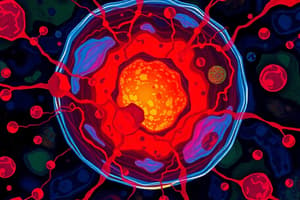Podcast
Questions and Answers
Which of the following is NOT a common cause of cell injury?
Which of the following is NOT a common cause of cell injury?
- Physical agents
- Psychological stress (correct)
- Chemical agents
- Inadequate oxygenation
What is the characteristic feature of reversible cell injury that involves the accumulation of water in the cytoplasm?
What is the characteristic feature of reversible cell injury that involves the accumulation of water in the cytoplasm?
- Hydropic change (correct)
- Fatty change
- Necrosis
- Apoptosis
Which of the following is a characteristic feature of irreversible cell injury?
Which of the following is a characteristic feature of irreversible cell injury?
- Increased ATP production
- Reduced membrane permeability
- Restoration of normal cellular function
- Mitochondrial swelling (correct)
What is the term for a localized area of ischemic necrosis in an organ?
What is the term for a localized area of ischemic necrosis in an organ?
Which of the following is NOT associated with the process of apoptosis?
Which of the following is NOT associated with the process of apoptosis?
Which of the following is a physiological example of apoptosis?
Which of the following is a physiological example of apoptosis?
Which of the following is NOT a characteristic of necrosis?
Which of the following is NOT a characteristic of necrosis?
What is the term for the accumulation of lipids, specifically triglycerides, in the cytoplasm of cells?
What is the term for the accumulation of lipids, specifically triglycerides, in the cytoplasm of cells?
Which type of cell adaptation involves an increase in the size of cells, leading to an increase in organ size?
Which type of cell adaptation involves an increase in the size of cells, leading to an increase in organ size?
Which type of cell adaptation involves a reversible change from one adult cell type to another?
Which type of cell adaptation involves a reversible change from one adult cell type to another?
Which of the following is a hallmark of oxidative stress?
Which of the following is a hallmark of oxidative stress?
How does ATP depletion contribute to cell injury?
How does ATP depletion contribute to cell injury?
What is a possible consequence of a prolonged unfolded protein response (UPR)?
What is a possible consequence of a prolonged unfolded protein response (UPR)?
Which of the following is a major contributor to the pathogenesis of ischemic reperfusion injury?
Which of the following is a major contributor to the pathogenesis of ischemic reperfusion injury?
Which of these is NOT an example of a type of cell death?
Which of these is NOT an example of a type of cell death?
What is the main function of the BCL-2 protein family in the mitochondrial pathway of apoptosis?
What is the main function of the BCL-2 protein family in the mitochondrial pathway of apoptosis?
Flashcards
Reversible Cell Injury
Reversible Cell Injury
A temporary impairment of cell function which can be restored.
Irreversible Cell Injury
Irreversible Cell Injury
Permanent damage to a cell that results in cell death.
Apoptosis
Apoptosis
Programmed cell death that eliminates excess or damaged cells.
Necrosis
Necrosis
Signup and view all the flashcards
Ischemia
Ischemia
Signup and view all the flashcards
Hypoxia
Hypoxia
Signup and view all the flashcards
Metaplasia
Metaplasia
Signup and view all the flashcards
Atrophy
Atrophy
Signup and view all the flashcards
Dystrophic Calcification
Dystrophic Calcification
Signup and view all the flashcards
Metastatic Calcification
Metastatic Calcification
Signup and view all the flashcards
Oxidative Stress
Oxidative Stress
Signup and view all the flashcards
Calcium Homeostasis
Calcium Homeostasis
Signup and view all the flashcards
Free Radicals
Free Radicals
Signup and view all the flashcards
Autophagy
Autophagy
Signup and view all the flashcards
Caspases
Caspases
Signup and view all the flashcards
Study Notes
Cell Injury and Death
- Adaptation: Cells respond to stressors by adapting, undergoing injury, or death.
- Reversible injury: Characterized by generalized cellular swelling (hydropic change) and fatty change, but fully reversible if stressor removed.
- Irreversible injury:
- Inability to recover from mitochondrial dysfunction (lack of oxidative phosphorylation + ATP production) and profound membrane disturbances.
- Occurs after ischemic insult in most organs except the brain.
- Types of Necrosis:
- Coagulative necrosis: Architecture preserved for a while, firm texture. Occurs in most organs (except brain) after ischemia.
- Liquefactive necrosis: Digestion of dead cells, creamy yellow appearance. Seen in brain ischemia and focal bacterial/fungal infections.
- Caseous necrosis: Granulomatous appearance under microscope, fragmented cells enclosed in inflammation border.
- Fat necrosis: Chalky white areas (saponification) due to pancreatic enzymes. Occurs in acute pancreatitis.
- Fibrinoid necrosis: Complexes of antigens and antibodies in vessel walls; bright pink and amorphous on H&E stains.
- Apoptosis: Programmed cell death, tightly regulated, no inflammation.
- Physiologic: removal of excess cells in development, involution of hormone-dependent tissues, elimination of self-reactive lymphocytes.
- Pathologic: DNA damage, accumulation of misfolded proteins, viral infections.
- Morphology: Cell shrinkage, chromatin condensation, cytoplasmic blebs, apoptotic bodies (phagocytosed).
- Pathways: Mitochondrial (intrinsic) and death receptor (extrinsic); both converge on caspase activation.
- Necroptosis: Necrosis-like cell death, triggered by excess iron or reactive oxygen species (ROS), looks like necrosis but regulated. Involves kinases RIPK1 and RIPK3.
Cellular Aging
- Cells have a limited capacity for replication, leading to cellular senescence.
- Telomere shortening, DNA damage, defective protein homeostasis, nutrient sensing, and insulin/IGF signaling contribute to cellular aging.
- Cellular senescent cells produce factors that induce inflammation and contribute to tissue dysfunction.
Pathologic Calcification
- Dystrophic calcification: Deposition of calcium salts in dying tissue despite normal serum calcium levels.
- Metastatic calcification: Deposition of calcium salts in normal tissues due to hypercalcemia (elevated blood calcium).
- Causes: parathyroid hormone (PTH) overactivity, vitamin D-related disorders, renal failure, hemochromatosis.
Other Cellular Damage
- Hypoxia/ischemia: Inadequate oxygenation of blood; often worse than hypoxia due to metabolite buildup. Key factor is hypoxia-inducible factor 1 (HIF-1) activation.
- Chemical injury: Direct binding to important molecules or conversion to toxic metabolites.
- Oxidative stress: ROS's (oxygen-derived free radicals) damage lipids, proteins, and nucleic acids that leads to cell injury.
- Calcium homeostasis disturbances: Excessive intracellular calcium activates enzymes that damage cellular components.
- Endoplasmic reticulum stress: Accumulation of misfolded proteins triggers apoptosis or cellular dysfunction.
Adaptations
- Hypertrophy: Increase in cell size (physiological or pathological, e.g., cardiac hypertrophy).
- Hyperplasia: Increase in cell number (physiological or pathological, e.g., benign prostatic hyperplasia).
- Atrophy: Decrease in cell size and number (e.g., reduced blood supply, inadequate nutrition, loss of endocrine stimulation).
- Metaplasia: Change in cell type, sometimes associated with increased cancer risk.
- Intracellular accumulations: Abnormal accumulation of substances like lipids, proteins, or pigments, e.g., fatty change.
Studying That Suits You
Use AI to generate personalized quizzes and flashcards to suit your learning preferences.




